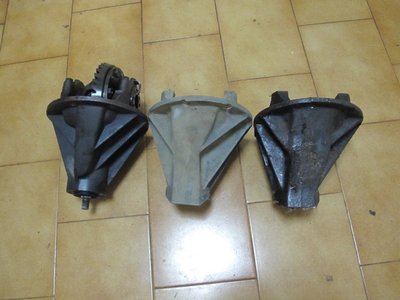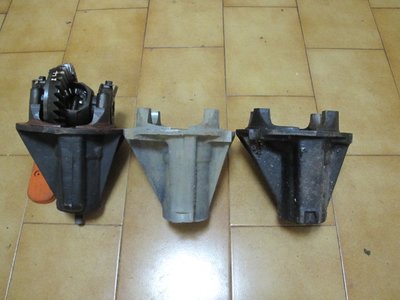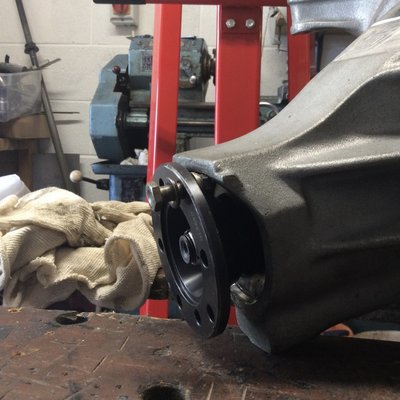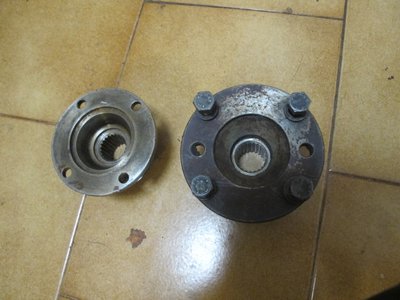light is right... but which light ? metallurgy question
20 posts
• Page 1 of 2 • 1, 2
considering a light diff nose for my S2 GTS project, I came across 2 alloy versions : in L155 and in L169
chatting with the supplier led to minor differences, L155 being presented as stronger but more brittle than L169, both being equally well suited for race use.
then an internet search lead me to the following
http://www.nortal.co.uk/BSL154%20and%20B5L155/
http://www.nortal.co.uk/BSL169/
besides small tensile and hardness small differences, I also noted a difference in thermal expansion (0.000024 vs. 0.000021) which is where aluminum alloy is reputedly source of issues on elan diff applications...
for completeness, I'm planning to mate this to a magnesium rear cover. Options for diff side adjusters are steel or Si Bronze (again for thermal expansion considerations)...
So I'm interested in any opinion from the forum, real life racing experience of course (esp. regarding any of the above alloys), but also from a metallurgy if the specs can lead to a clear conclusion...
thank you all for any insight or observation !
chatting with the supplier led to minor differences, L155 being presented as stronger but more brittle than L169, both being equally well suited for race use.
then an internet search lead me to the following
http://www.nortal.co.uk/BSL154%20and%20B5L155/
http://www.nortal.co.uk/BSL169/
besides small tensile and hardness small differences, I also noted a difference in thermal expansion (0.000024 vs. 0.000021) which is where aluminum alloy is reputedly source of issues on elan diff applications...
for completeness, I'm planning to mate this to a magnesium rear cover. Options for diff side adjusters are steel or Si Bronze (again for thermal expansion considerations)...
So I'm interested in any opinion from the forum, real life racing experience of course (esp. regarding any of the above alloys), but also from a metallurgy if the specs can lead to a clear conclusion...
thank you all for any insight or observation !
Last edited by nmauduit on Thu Jul 11, 2019 12:27 pm, edited 1 time in total.
S4SE 36/8198
-

nmauduit - Coveted Fifth Gear

- Posts: 1998
- Joined: 02 Sep 2013
Those things are so expensive compared to the weight saving!! If you weigh a cast iron carrier yes they are heavier. Inside though you've still got heavy steel gears, steel bearings, heavy differential gear housing (even more heavy with LSD), etc. so in term of overall % weight loss it's not all that great. Lotus and Ford saw the light  and reverted back to cast iron for later models. Plus you don't have to worry about thermal expansion issues. You might even get better front/rear weight distribution with one! They're more an issue on a live rear axle car where you don't want all that unsprung mass hopping around.
and reverted back to cast iron for later models. Plus you don't have to worry about thermal expansion issues. You might even get better front/rear weight distribution with one! They're more an issue on a live rear axle car where you don't want all that unsprung mass hopping around.
1970 Ford Escort Twin Cam
1972 Ford Escort GT1600 Twin Cam
1980 Ford Escort 2.0 Ghia
Peugeot 505 GTI Wagons (5spdx1) (Autox1)
2022 Ford Fiesta ST.
1972 Ford Escort GT1600 Twin Cam
1980 Ford Escort 2.0 Ghia
Peugeot 505 GTI Wagons (5spdx1) (Autox1)
2022 Ford Fiesta ST.
- 2cams70
- Coveted Fifth Gear

- Posts: 2163
- Joined: 10 Jun 2015
I have not done a detailed analysis of the two alternatives but on the surface would probably choose the 169 as it is closer to the original cast iron in its characteristics and will need the least adjustment in tolerances and clearances to work. its a lot of work to do the detailed analysis and because I am not allowed to use the light weight components in my class i have never had the need to do it.
Whats critical is to have sufficient interference fit of the bearing races when the diff is hot. This will need greater interference fit when cold for the alloy casings than for cast iron and the w coefficient of expansion makes this easier to achieve. i would ask the manufacturer how they have adjusted the bearing fits to suit the alloy versus original cast iron casting. I they cant give a sensible answer I would look elsewhere. if I bought a casting based on their information I would then check measure and do the detailed analysis to determine their claims and manufacture actually have been achieved with the needed detail machining changes and return if not done correctly
cheers
Rohan
Whats critical is to have sufficient interference fit of the bearing races when the diff is hot. This will need greater interference fit when cold for the alloy casings than for cast iron and the w coefficient of expansion makes this easier to achieve. i would ask the manufacturer how they have adjusted the bearing fits to suit the alloy versus original cast iron casting. I they cant give a sensible answer I would look elsewhere. if I bought a casting based on their information I would then check measure and do the detailed analysis to determine their claims and manufacture actually have been achieved with the needed detail machining changes and return if not done correctly
cheers
Rohan
-

rgh0 - Coveted Fifth Gear

- Posts: 8413
- Joined: 22 Sep 2003
Than you for your reply Rohan, here's an update on that front:
eventually L155 was selected, though the more I dig the more contradiction I find about the infos/advice initially given now favoring the alternative...
my gut feeling upon looking up the Nortal specs was that L169 was better suited too, though my conclusion is that it should not make a big difference for me in the end.
it's still in the UK and will be assembled there, so I can't check specific tolerancing.
the alloy casing has tighter clearance than the cast iron nose, so this goes in the right direction.
a 4.4:1 crown set from Quaife will complete it, with their "superfinish" on it (my friend had a similar surface treatment on the gears of his gearbox and I found that very nice, reduces the oil temp, too)
Now I'll have to work on an engine to put it to test (8.8k-9k is the target), will certainly get back to you on how to achieve that for more than a couple laps...
eventually L155 was selected, though the more I dig the more contradiction I find about the infos/advice initially given now favoring the alternative...
my gut feeling upon looking up the Nortal specs was that L169 was better suited too, though my conclusion is that it should not make a big difference for me in the end.
it's still in the UK and will be assembled there, so I can't check specific tolerancing.
the alloy casing has tighter clearance than the cast iron nose, so this goes in the right direction.
a 4.4:1 crown set from Quaife will complete it, with their "superfinish" on it (my friend had a similar surface treatment on the gears of his gearbox and I found that very nice, reduces the oil temp, too)
Now I'll have to work on an engine to put it to test (8.8k-9k is the target), will certainly get back to you on how to achieve that for more than a couple laps...
S4SE 36/8198
-

nmauduit - Coveted Fifth Gear

- Posts: 1998
- Joined: 02 Sep 2013
I agree that provide the interference dimensions and tolerancing is correct for the selected alloy it should not make a huge difference as to which alloy is selected as both can be made to work. It really depends on whether the manufacturer has done the design adjustments right for the alloy used.
cheers
Rohan
cheers
Rohan
-

rgh0 - Coveted Fifth Gear

- Posts: 8413
- Joined: 22 Sep 2003
Hi,
It is not just the material there is also more than one design.
One is as the original shape and one has more material around the nose section - probably stiffening this area, so you would think that was a good thing but If you fit the TTR input mounting, then that uses nuts and bolts whereas original uses just bolts to mount the prop shaft. The nuts foul the extended alloy nose bit, so on mine I had to cut the extended nose piece off.
The TTR mounting flange is much better / easier when fitting or removing the prop shaft.
Regards
Steve
It is not just the material there is also more than one design.
One is as the original shape and one has more material around the nose section - probably stiffening this area, so you would think that was a good thing but If you fit the TTR input mounting, then that uses nuts and bolts whereas original uses just bolts to mount the prop shaft. The nuts foul the extended alloy nose bit, so on mine I had to cut the extended nose piece off.
The TTR mounting flange is much better / easier when fitting or removing the prop shaft.
Regards
Steve
- patrics
- Fourth Gear

- Posts: 534
- Joined: 21 Sep 2003
patrics wrote:Hi,
It is not just the material there is also more than one design.
One is as the original shape and one has more material around the nose section - probably stiffening this area, so you would think that was a good thing but If you fit the TTR input mounting, then that uses nuts and bolts whereas original uses just bolts to mount the prop shaft. The nuts foul the extended alloy nose bit, so on mine I had to cut the extended nose piece off.
The TTR mounting flange is much better / easier when fitting or removing the prop shaft.
Regards
Steve
interesting: would you please detail further (what version you have, the amount of negative clearance that needed to be removed, if some other circumstances may have contributed to that like a special chassis etc.), as both versions on their site (L155 and L169) are stated as "pre '65 homologated shape" ?
thank you !
S4SE 36/8198
-

nmauduit - Coveted Fifth Gear

- Posts: 1998
- Joined: 02 Sep 2013
nmauduit wrote:"pre '65 homologated shape"
That will refer to the Ford Anglia / Mk1 Cortina carrier housing (105E part number). Below I've attached pictures of 3 out of the 4 different types of carrier shapes. From left to right from earliest production to latest we have the Ford Anglia type (this example actually came from an Elan), The early MK1 Escort type (2920E part number), The late Mk1 / Mk2 Escort type (73AG part number). The 4th type that is missing in the pictures is between the Ford Anglia and Mk1 Escort types and was fitted to Mk2 Cortinas and crossflow engined Capris (118E part number from memory).
The carriers differ in design of the lower boss. The 105E type is rounded in shape with no machining, all later carriers have the square shaped lower boss with a semi-circular machined cutout. The square boss is what causes all the heartache when fitting in an Elan chassis. It appears to me that Ford added the square shaped boss with machined cutout to aid in production line assembly. The semi-circular cutout was probably used for locating some kind of fixture during assembly. It serves no functional purpose.
The carriers differ in design of the topmost rib. Apart from the early 105E type carrier the topmost rib extends over the pinion oil seal. I assume Ford added this design change to incorporate a form of shielding to help prevent stones and other debris from damaging the oil seal.
The thickness of the topmost rib also increases progressively through the four designs. I assume Ford did this in order to strengthen the carrier so it would cope with engines of increasing torque through the product lifecycle. The more torque an engine has the greater the force acting between the gears hence the need for a carrier with more resistance to longitudinal bending stresses. The earliest carrier (with perhaps just a bit of safety factor!!) was designed for a puny 997cc OHV engine. The last 73AG carrier on the other hand was designed to cope with the torque from the 2.0 litre Pinto OHC engine. The Mk1 Pinto engined RS2000 Escort was introduced in 1973 in the UK hence that's where the 73AG part number probably originates from.
The 118E carrier not shown here is a bit of a hybrid. It has a similar top rib to the 105E carrier but has the square shaped lower boss with machined cutout. It seems Ford had some production engineering issues quite early on!
It's obvious from all this that the original designers thought long and hard about things. I wonder if the aftermarket makers of light alloy carriers share the same level of insight. A lot of them seem to be just copies of the 105E shaped carrier except in Aluminium instead of cast iron with maybe a bit of extra thickness of the mounting flange. Aluminium has significantly different properties to cast iron though!!
1970 Ford Escort Twin Cam
1972 Ford Escort GT1600 Twin Cam
1980 Ford Escort 2.0 Ghia
Peugeot 505 GTI Wagons (5spdx1) (Autox1)
2022 Ford Fiesta ST.
1972 Ford Escort GT1600 Twin Cam
1980 Ford Escort 2.0 Ghia
Peugeot 505 GTI Wagons (5spdx1) (Autox1)
2022 Ford Fiesta ST.
- 2cams70
- Coveted Fifth Gear

- Posts: 2163
- Joined: 10 Jun 2015
patrics wrote:Hi,Attached should be a photo - as you can see I am using K nuts and it still fouls.RegardsSteve
What final drive flange diameter are you running? There's several different ones. Yours looks like the largest diameter one with larger bolt PCD. The largest diameter OEM ones have threads in the flange so bolts only, no nuts and therefore no interference.
1970 Ford Escort Twin Cam
1972 Ford Escort GT1600 Twin Cam
1980 Ford Escort 2.0 Ghia
Peugeot 505 GTI Wagons (5spdx1) (Autox1)
2022 Ford Fiesta ST.
1972 Ford Escort GT1600 Twin Cam
1980 Ford Escort 2.0 Ghia
Peugeot 505 GTI Wagons (5spdx1) (Autox1)
2022 Ford Fiesta ST.
- 2cams70
- Coveted Fifth Gear

- Posts: 2163
- Joined: 10 Jun 2015
patrics wrote:Hi,
Attached should be a photo - as you can see I am using K nuts and it still fouls.
Regards
Steve
That looks like a 3J casing, not the same as a TTR in question so the issues are slightly different here. TTR casing doesn't have the bearing and seal "hood".
I think the latest Ford cast iron diff housing (with the hood) was beefed up around the top face to strengthen it and to also act as a "bump-stop" surface for mk1 mk2 escorts etc.
Craven wrote:Looks like a mix of housing and flange; I associated that housing with the metric flange that had tapped fixing holes.
Agreed, and is likely the reason Ford went to threaded holes.
-

promotor - Fourth Gear

- Posts: 797
- Joined: 16 Mar 2012
Your carrier is based on the 73AG style. Picture of OEM flange for the carrier style you have is on the RHS. Bolt size is M10 x 1.0 x 20mm long with tapped flange holes. Flange diameter is 107mm, bolt PCD 90mm and flange ID is 56mm
1970 Ford Escort Twin Cam
1972 Ford Escort GT1600 Twin Cam
1980 Ford Escort 2.0 Ghia
Peugeot 505 GTI Wagons (5spdx1) (Autox1)
2022 Ford Fiesta ST.
1972 Ford Escort GT1600 Twin Cam
1980 Ford Escort 2.0 Ghia
Peugeot 505 GTI Wagons (5spdx1) (Autox1)
2022 Ford Fiesta ST.
- 2cams70
- Coveted Fifth Gear

- Posts: 2163
- Joined: 10 Jun 2015
thank you all
any chance you could switch the direction of the fasteners (like on the gearbox of an Etype) so as to provide enough clearance for a short head bolt?
patrics wrote:Hi,
Attached should be a photo - as you can see I am using K nuts and it still fouls.
any chance you could switch the direction of the fasteners (like on the gearbox of an Etype) so as to provide enough clearance for a short head bolt?
S4SE 36/8198
-

nmauduit - Coveted Fifth Gear

- Posts: 1998
- Joined: 02 Sep 2013
What size bolts have they provided with the flange? You may be able to Helicoil the flange with threads. Ed. Sorry - why would you Helicoil? Just tap!!
1970 Ford Escort Twin Cam
1972 Ford Escort GT1600 Twin Cam
1980 Ford Escort 2.0 Ghia
Peugeot 505 GTI Wagons (5spdx1) (Autox1)
2022 Ford Fiesta ST.
1972 Ford Escort GT1600 Twin Cam
1980 Ford Escort 2.0 Ghia
Peugeot 505 GTI Wagons (5spdx1) (Autox1)
2022 Ford Fiesta ST.
- 2cams70
- Coveted Fifth Gear

- Posts: 2163
- Joined: 10 Jun 2015
20 posts
• Page 1 of 2 • 1, 2
Total Online:
Users browsing this forum: No registered users and 9 guests






